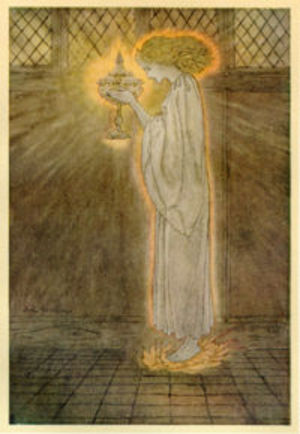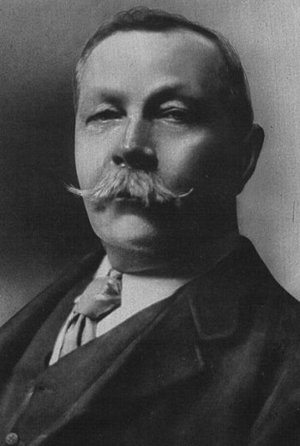The Holy Grail is one of the most controversial mythical objects in history. It is believed to be many things, varying from the cup that Christ and the disciples drank out of at the last supper, to what we learned in class as it actually being a head (or, to go with Professor Hall’s theory, a stepladder). The Grail was representative of the values of the knights, as in many of the various legends of Arthur and his knights, the knights could rarely aspire to the level of purity that was required to obtain the grail. Even Sir Galahad, in one of the legends, was only pure enough to simply see the grail, but even he could not obtain it. This exemplifies the idea that the Grail could not be obtained by just anyone, but rather it could only be obtained by the purest of people. Again, the Grail itself is a mystery, as no one has seen its true form, so that it could have easily been something simple as a clay cup. Finally, part of the mystery of the Grail is that it is not necessarily known where it is located. Hollywood and various other movies have tried to make up a location for the Grail, but many times these locations have no real sense, or their location is so false that it could only be done in a movie. There are several cathedrals that claim to have the Grail, and there are also two other locations that people believe that the Grail may be hidden, but as of yet these rumors have not been proven.
Many people throughout history have searched out the grail, from the time of its appearance in the Arthurian Romances through the Crusades, in hopes to find this most holy of relics. Of course none have verifiably succeeded, though some places do have what they claim to be the grail. Valencia, on the east coast of Spain, is one such place that claims to have the Grail. Also on the list, or rather, previously, was Genoa in Northern Italy, who had an emerald chalice that was supposedly the grail, which was appropriated in Aleppo during the crusades. Unfortunately, this was proven to be false when the chalice was dropped on return from Paris and broken. The grail could also be hidden, as many different legends point towards the well at Glastonbury Tor. One of the more common locations that it is believed that the grail is located, many feel that the grail is actually in a spring or well there. Others believe that the Grail is underneath Rosslyn Chapel in Scotland. Still other rumors persist that the Grail is in Nova Scotia or even in the United States. Whether these rumors are true or not, again, is unknown, but some of them are rather unlikely.
Also, the Grail may not be the Grail that everyone thinks that it is. In the myths of Christianity, the Grail is not the cup that Christ used at the last supper, but rather the one that caught the blood of Christ at his crucifixion. This could open up a whole new problem, as people who have been searching for the Holy Grail, if it does exist, may be searching for the wrong thing. The cup that they are searching for would probably in fact be a simple clay or wooden chalice, instead of a magnificent cup as the grail is sometimes described. There are, in modern times, four possible contenders for the Holy Grail, two of which still survive in some form and were mentioned earlier. One was believed to be in Constantinople, or was rather believed to be a copy of the original grail. As mentioned in The Younger Titurel; “A second costly dish, very noble and very precious, was fashioned to duplicate this one. In holiness it has no flaw. Men of Constantinople assayed it in their land, (finding) it richer in adornment, they accounted it the true grâl.” Perhaps the grail had been found at one point in time, and someone made an identical copy of it, however, due again to the specificity of the legends, this seems unlikely. It also seems unlikey, though more likely than before, that the grail actually existed in Jerusalem, and actually may have been the chalice used at the last supper (remember, this is not the same as the grail), and actually the accouts of it went back before the actual addition of the grail into the legends of Arthur and his knights.
Another view of the discovery of the grail goes into some of the legends surrounding it. The Grail was something of a enigma, that it could not be obtained except by the purest of souls. There are various accounts of what happens to the knights on their quests. Some have accounts of the knight seeing the grail, as Perceval did in the story written by Chrétien de Troyes, to Galahad seeing the grail, but still not being able to obtain it because he was only human, to Lancelot absloutely failing at his attempt becauase he was not pure. The ideals of chivalry were an absolute necessity to obtain the grail, but there needed to be someone who was absolutely infalliable, and, while Galahad seemed that way, he too was only human, and was worthy enough to get to see the grail.
But then there are also those legends of Arthur and his knights that actually achieved the grail. Percival, Bors, and Galahad all achieved the grail in various accounts of the quests for the Holy Grail, and there is also an account of 12 knights who found the grail, and ascended into heaven with it. This account would support the idea that the grail does not actually exist in modern times, but that it may have existed at some point. However, the conflict in between the various stories suggests that the grail may have existed, may not exist, and may actually have been discovered and subsequently lost.
Modern movies have attempted to draw the grail into them at some points. Probably foremost in most peoples minds is the movie Indiana Jones and the Last Crusade. From what I have found, the actual storyline does support a lot of what is written, and, from the viewpoint of the actual Arthurian Legends, is very accurate, as it supports several theories. One of the theories that was supported by Last Crusade is the idea that the grail does exist and there is a lineage of people who are destined to guard the grail with their lives. Also, the grail chamber supports these ideas that there are a lot of false grails, as there was only one grail that was the true one, while the rest of them were fakes. Only the true one was able to actually heal everything (which is also supported in vaarious legends), while the fake ones would draw the life away from a person (as a side note, this could be seen as a form of damnation to those who claimed to have the grail while it was actually false. Something of that importance should not be made a mockery of, and that is actually exhibited in the cave). Granted that the various trials that were required of those seeking the grail were unlikely, it would be no surprise if something like the trials at the Canyon of the Crescent moon existed. The power that the Grail would grant, both in the legends and its powers in the movie (again, the grail was able to heal all disease, injury, etc.), would give the person almost absolute power. Given that the power would be used for healing, it would still be something that only one that was worthy could receive.
The Grail is a very complicated thing. Whether it was simply a legend that was added into the legends of Arthur and his knights, or whether or not it existed, or, in fact, was a combination of the two, is a matter that can be discussed for some time. I feel for the latter, simply because the grail itself seems like an impossibility, but there are very many things that happen in history that are also impossibilties. Angels descending from heaven administering communion to people, while everyone that is watching cannot see, would put the feasability of the grail into truth. Mystical things can happen, and the appearance of the grail would be logically possible with everything else that has happened in terms of religion and paranormal things. The grails existance may well be attributed to what happens with those looking for it, or, if it was as powerful as it is suppposed to be, then it might appear if there would be some immediate need for it, such as a nuclear holocost. I know it sounds kind of extreme, but given the mythology of it, this sort of event would be quite possible.
As far as who could be able to attain the grail, it would have to be someone who would have a good sense of justice and a strong will for good. It would be something that your ordinary person would not be able to get. Actually the ideal person that would be able to attain it would be a child, or someone with that kind of mindset. A child has no real greed, power has no meaning to them. All in all, a child in this case could be quite a bit more responsible for this most sacred of things than an adult would be. An adult would be probably overcome with some sort of power trip, and decide to charge people to use something that would be so powerful. Only one who would be naïve to the ideals of greed and power would and should be able to attain and protect such a thing. Not to necessarily say that a child should be the person that should be protecting it, but someone who would be absolutely pure of heart, devoid of self desire, and must have the absolute desire to stand up to the values needed for the grail.
The Grail itself may actuall be something of an enigmatic form itself. Sometimes what something is is not what it seems to be. The grail could concieveably change forms, being an object of great importance. Given that I do not believe that the Grail does exist, as I generally only believe in what I see, I do think that the Grail may actually have some other form, and that the form could change. As I mentioned at the beginning, the Grail could have been described as many different things, a chalice, a head, a plate. I think I could be anything, and can become anything, to keep its actual identity secret from people. Something of such importance would be something to keep out of human hands, and if people cannot identify what it is, people will not necessarily put any importance to it. It may well be something that is seen but never seen, protected, yet unknown to its protector. The best way to protect something is to give it to someone who does not recognize it.
The knights of England and the crusades have not always looked for the holy grail however. The knights have a code of honor that they follow, and this is part of the basic requirements of being able to get the grail. The code of chivalry was to be brave in battle, loyal to their Lord and God, courteous to their countryman, and kind and gentlemanly to the ladies. All of these things would make the knight pure, though there are also other requirements to being pure which are kind of self explanatory. To uphold the ideas of the knight was to reach the state of mind and honor that was needed to attain the grail. Most knights did not actively seek the grail, but they still followed this code most of the time, as a form of rasing the reputation of those that they served. Of course, a king is going to like his knight if his knight does something honorable, but the king would be disgraced if the knight were to do something that was ooutside of those chivalric rules. The code was a form of control for the knight as well, although sometimes a knight could go rogue and start going after citizens, in essence be a bully, in which case the knight, if he served under a lord that was supposed to be just, would lose his knighthood at best. To most knights, honor was above all else, similar to the ideals of the samurai in Japan, though to be dishonored did not necessarily mean that death was the only option, but there could be worse punishments.
The ideals of knights have disappeared over the years. Of course, not many people are actively seeking the Holy Grail anymore, and even fewer are actually able to find it. The ideals of the knight have greatly diminished over the years, and now people who are knighted are not necessarily knighted for their actions in terms of chivalry, but are knighted for what they do for the general public. Granted now there are fewer and fewer opportunities to show the values of bravery and courage, knighthood has lost some of that edge of knights and rather as a sort of figurehead of the people.
The Grail could also be a type of control for a knight, as was stated in Troyes story of Percival. Percival was one who desired to find the grail, and in actuality saw the grail at one point, but he also found himself tempeted often. In the end, he ended up castrating himself to prevent himself from falling out of that pure state so that he might obtain the grail, which, again, in some instances he does find the grail, in Troyes he sees the grail, which could heal the lord, but since he never asked what it was, he failed to get it and heal the lord. This may also be an example of how a knight, no matter how chivalric he is, may have some downfall at some point, as is well known about Percival, he is kind of dumb, and does some things that were more or less done out of naivete instead of because he wanted to. He had his failings, but those were more based on his upbringing (Troyes).
As seen, th grail and its quest can be a very difficult story for a person to understand. The grial itself could be just about anything, and the manner of obtaining it, no to mention its basic location, are also likewise unknown to anyone. For a person to fully appreciate the grail, one must understand both what the grail stood for (God, power, helping others, chivalry), as well as what the chivalric code of the medieval era meant. Without understanding these basic things about it, there is no way that one can fully appreciate the stories of Arthur and his knights. To obtain the Grail, one had to be pure in heart and deed, to never have fallen to temptation; for humans an impossible task, as everyone falls at some point. But it also must be known that the Grail, in the legends anyway, may have also been found. It is hard to know this because of the multiple people who have written about the stories of Arthur and his knights, and the varying viewpoints each had on the matter. But, as it stands, the story of the Grail is simply a legend, something that people may attempt to aspire to, but will never attain.
Works Cited
Chrétien de Troyes Arthurian Legends © 1991 Penguin Books





